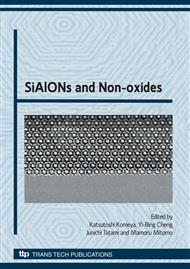p.135
p.139
p.141
p.147
p.149
p.153
p.157
p.159
p.163
A New Route of Forming Silicon Carbide Nanostructures with Controlled Morphologies
Abstract:
Mesoporous silica-carbon nanocomposites (C-SiO2) were synthesized and used as a host carrier in carbothermal reduction to fabricate highly crystalline silicon carbide nanoparticles and nanofibers. SiC nuclei were introduced into the mesopores as seeds by infiltration of preceramic precursor polycarbosilane (PCS) prior to the heat-treatment of carbothermal reduction. X-ray diffraction, scanning electron microscopy, transmission electron microscopy, and nitrogen adsorption-desorption analysis were used to characterize C-SiO2 nanocomposites and SiC products. Crystalline SiC was not formed in the mesoporous C-SiO2 nanocomposites with a low carbon content (e.g. C/SiO2 ratio = 1.01) at 1450 °C. However, when a given amount of PCS was infiltrated into the mesoporous C-SiO2, SiC nanofibers and nanoparticles were produced at 1450 °C even in the low carbon content sample. The major morphology formed from the mesoporous C-SiO2 nanocomposites without PCS infiltration was nanoparticles, while nanofibers dominated in the products of the PCS infiltrated compositions. The results indicate that the conversion of PCS into SiC nuclei in mesopores prior to carbothermal reduction has facilitated the formation of SiC nanofibers. Therefore infiltration of seeds into mesopores of C-SiO2 precursors appears to be an effective means in accelerating the reaction and controlling of nanostructures of silicon carbide.
Info:
Periodical:
Pages:
149-152
Citation:
Online since:
December 2008
Authors:
Keywords:
Price:
Сopyright:
© 2009 Trans Tech Publications Ltd. All Rights Reserved
Share:
Citation:


